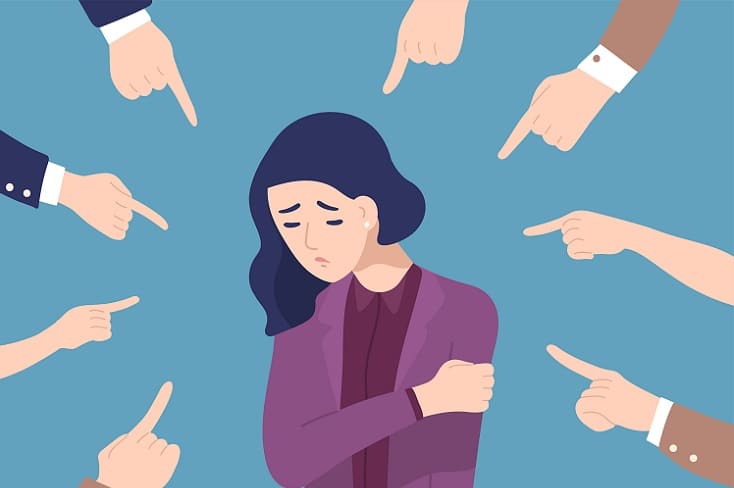October 08, 2020
By Ashley Peterson
 People tend to fear the unknown. While there is prejudice associated with most mental health conditions, psychosis is arguably the symptom the average person finds the most frightening.
People tend to fear the unknown. While there is prejudice associated with most mental health conditions, psychosis is arguably the symptom the average person finds the most frightening.
Psychosis refers to a cluster of symptoms involving hallucinations, delusions and/or profound disorganization. It can occur in primary psychotic disorders, like schizophrenia or schizoaffective disorder, and also in other conditions like bipolar disorder or major depressive disorder.
To the uneducated person, though, there’s likely to be a lumping together of “psychosis = crazy = schizophrenic = frightening = dangerous.” They reality of psychosis is simply not a part of the social dialogue. Since it is not understood, stereotypes are clung to more tightly when evaluating or contextualizing someone who appears to have psychosis.
As someone who has experienced both hallucinations and delusions, and as a mental health nurse, I want to set the record straight on why the most common stereotypes about psychosis are inaccurate and potentially harmful to the people experiencing them.
You should fear the broken system, not the people it has failed
There is a stereotype of the disheveled, smelly person living on the street. This is the person whom the rest of society views as somehow less human and a lost cause. It likely stems at least in part from an underlying fear that the onlooker could someday end up in that position. However, when people with psychosis do end up resembling this stereotype, it’s because the system has failed them on multiple levels, repeatedly. It is not the unkempt homeless person that you should fear, but rather the mental health system that’s so broken it can’t catch people when they fall.
People aren’t talking to themselves, they’re responding to their reality
One classic stereotype of psychosis is someone talking to themselves. This is a bit of a misnomer in that people aren’t actually talking to themselves, they’re responding to their hallucinations. This can be observed sometimes, particularly when people are highly unwell, but as a broad generalization, it’s just not accurate.
The tinfoil hat is only in movies
Another stereotype is the tinfoil hat. While it’s true that severe paranoia may lead some people to take steps to protect themselves from perceived outside energies, radiation or mind-reading attempts, this is not a run-of-the-mill occurrence for most people experiencing psychosis. When this kind of paranoia manifests, it’s more likely to trigger perceived protective measures around the home. In 15 years of nursing, I’ve never seen an actual tinfoil hat, but I have witnessed some elaborate strategies in people’s homes, including covering windows with paper and taping over electrical outlets.
Having psychosis does not make you violent
Perhaps the most harmful stereotype is the assumption that someone with psychosis is inherently violent or dangerous. There’s yet another mass shooting? Suddenly everyone’s blaming people with mental illness and saying, “the shooter must have been crazy.” Because after all, how could someone do something like that and not be “psychotic”?
However, the fact is that the majority of people with serious mental illness are not violent and are far more likely to be the victims of violence than perpetrators. However, for the small portion who may use violence, it is other risk factors that are more likely to be related, such as gender and prior violence, not the experience of psychosis itself.
People with psychosis are not “psycho” or “psychopaths”
There is a lot of confusion between psychosis and psychopathy. Many people jump to the conclusion that “psychotic = psycho = psychopath.” This, simply put, is wrong. To clarify, “psychotic” is an adjective for someone experiencing psychosis, while “psychopathy” is the lack of or inability to experience empathy, which is an entirely separate issue. “Psycho” is a slang term that derives from the Latin word psyche, meaning mind or soul, but gets tossed around loosely to label anyone who’s seen as “crazy,” despite being both insensitive and offensive to those with psychosis.
This is precisely why language around psychosis is so important. We cannot use words like “psycho” or even “psychotic” to define people experiencing psychosis because it leads society to associate psychosis with these harmful stereotypes. However, words are a minor issue compared to the fear surrounding psychosis. Fear flourishes in silence, which means we need to talk about what psychosis really looks like.
Maybe it’s not psychosis itself that’s perceived as scary, but rather the tightly held fear of the unknown. The best way to dispel that fear is by raising our voices.
Note: This article was originally published at http://mentalhealthathome.org.
Ashley Peterson is a mental health blogger and mental health nurse living with depression. She is the author of three books, latest is managing the depression puzzle. You can follow her writing at mentalhealthathome.org.
Submit To The NAMI Blog
We’re always accepting submissions to the NAMI Blog! We feature the latest research, stories of recovery, ways to end stigma and strategies for living well with mental illness. Most importantly: We feature your voices.
LEARN MORE